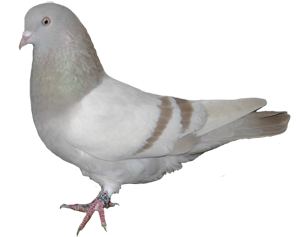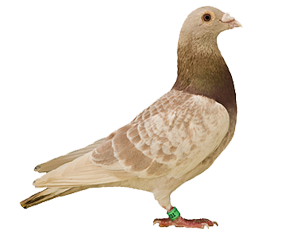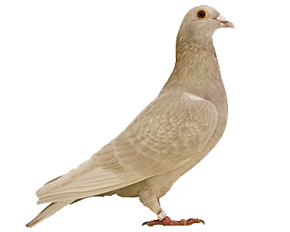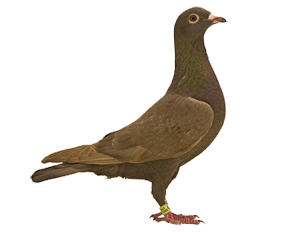
9. X-Pigeons |
||||
b - Brown
According to Willard F. Hollander, the “brown” or “chocolate” factor is recessive to wild-type black pigment at the b locus and is also sex-linked. This gene must be fairly ancient but was first recognized as different from the sex-linked “dilution” factor in 1924, by Metzelaar at the University of Michigan. The two Norwegian workers, Christie and Wriedt (1927), first demonstrated that brown is recessive and sex-linked in relation to black. This was soon confirmed by Steele (1928).
Pigeons are able to produce at least three pigments on their feathers which are red, black and brown. At some point genes producing wild-type phenotype (blue bar) must have mutated and became an alternative (allele) to wild-type at the b-locus. It is important to notice that the occurrence of black and brown, as alleles, is found in many higher animals besides pigeons. Brown is very common in large pigeon breeds such as Runts, Mondains, Hungarians, Strassers, and Kings. However, brown does not occur in all pigeon breeds unless there was intercrossing. In the groups where brown is absent, we find dilution (dunn) usually common. The brown is usually confused with, and known as dun or silver, although brown is genetically entirely different color. According to Joe Quinn, dun is dilute black and short downed in the nest, whereas brown is normal downed. The coloration of brown varies but approaches chocolate in most phenotypes, whereas dun approaches gun metal (bluish-brown) in most phenotypes.
 The
brown phenotype can be distinguished by the fact that it is between
dun and silver but also
shows chocolate or cocoa color. The
brown pigment
granules in brown birds look like the black pigment found in wild-type,
where brown pigment gives us a "silvery" color, but in reality
they are brown pigments under a microscope. Spread brown pigment gives
us a dark cocoa colored bird. Under the microscope a dun (dilute version
of blue/black) pigeon is going to have pigment granules way too small
to resolve. A brown pigeon
will
have pigment granules of normal size. So the size difference is diagnostic
between brown and dilute blue spread. In addition, the baby brown chicks
are always normal-downed, unlike silver or dun babies. The eyes in young
dilute brown squabs appear like albino eyes but gradually become darker
as the birds approach maturity. Also, most brown birds show false pearl
eye, but this doesn’t mean every pearl eye bird is a brown since
a dun bird can also have pearl eyes. According to Joe Quinn, brown pigeons
seldom have orange eyes (wild type) because the mutant affects certain
aspects of iris pigmentation producing creamy white “pearl-like” eye
coloration. This so-called “false pearl” eye and it is a
good identification clue for brown.
The
brown phenotype can be distinguished by the fact that it is between
dun and silver but also
shows chocolate or cocoa color. The
brown pigment
granules in brown birds look like the black pigment found in wild-type,
where brown pigment gives us a "silvery" color, but in reality
they are brown pigments under a microscope. Spread brown pigment gives
us a dark cocoa colored bird. Under the microscope a dun (dilute version
of blue/black) pigeon is going to have pigment granules way too small
to resolve. A brown pigeon
will
have pigment granules of normal size. So the size difference is diagnostic
between brown and dilute blue spread. In addition, the baby brown chicks
are always normal-downed, unlike silver or dun babies. The eyes in young
dilute brown squabs appear like albino eyes but gradually become darker
as the birds approach maturity. Also, most brown birds show false pearl
eye, but this doesn’t mean every pearl eye bird is a brown since
a dun bird can also have pearl eyes. According to Joe Quinn, brown pigeons
seldom have orange eyes (wild type) because the mutant affects certain
aspects of iris pigmentation producing creamy white “pearl-like” eye
coloration. This so-called “false pearl” eye and it is a
good identification clue for brown.
Here is an explanation of false pearl eye found in brown pigmented pigeons by Dr. Richard Cryberg:
“When you look at the outer portion of the eye which we call the iris you see an orange red color if it is wild type. This color varies quite a bit from bird to bird. The color is caused by a combination of three things. First there are small blood vessels in the iris and the blood gives the red color. There also is an orange pigment and a white pigment present. These latter pigments are produced by modified nerve cells that look almost identical to melanocytes and in fact may simply be melanocytes with a slightly different function. These cells produce a white pigment called guanidine and an orange pigment called a pterodine. It is a combination of these two pigments plus blood that give the iris its color. The biochemistry involved in producing the two pigments has been only very poorly studied so not much is known. However, to make black melanin we do know that a material called tyrosinase receptor protein is required It tyrosinase receptor protein is defective you get brown instead of black pigment. I think it is likely that tyrosinase receptor protein is also needed to make pterodine. So, on a brown pigeon you have defective tyrosinase receptor proteins thus are unable to make the orange pigment in the eye. But it seems you still make quanidine which is a white color so the net result is a false pearl eye”.
Brown is another pigment that pigeons are able to produce and it is believed to be an allele to wild-type at the b locus of the sex-chromosome. The genetic symbol for brown is lower case b, indicating that it is a sex-linked recessive gene. Brown is recessive to blue/black (wild-type). Brown birds also have dark sub-terminal tail bands and this color is as dark as the color visible in the bars. This mutation changes the base color from a bluish gray to a brown gray. Unlike the wild-type -- blue/black, brown pigments fade considerably when bleached by the sun but no one really knows why this is happening to brown pigmented feathers only. After a month of full sun the brown feather is nearly white. The outer tails in the brown based birds (except in spread) also have albescent strip, just like the blue based phenotypes. The pictures below are submitted by Vahe' D'Ala. www.falconlofts.com
 |
 |
 |
Faded Brown Check |
Milky Brown T-Check |
Spread Brown |
Homozygous brown cock - Both feather pigment alleles are brown; he has no choice but to donate brown during mating. If he is mated to an ash-red hen, all the male offspring will be ash-red carrying brown and all the female offspring will be brown. If he is mated to a blue hen, all the male offspring will be blue carrying brown and all the female offspring will be brown. If this cock is mated to a brown hen, then all the offspring will be brown. A brown cock has to be homozygous to express brown since brown is recessive to both ash-red and blue. So, is it possible for this cock to produce brown cock offspring? The answer is yes, but only if he is mated to a brown hen. Otherwise, all the male offspring from this cock will be either heterozygous ash-red carrying brown or heterozygous blue carrying brown. However, all the hens from this cock will be brown.
Homozygous brown cock X ash-red hen - All the cock birds will be
heterozygous ash-red carrying brown, all the hens will be brown.
Homozygous brown cock X blue
hen - All the cock birds will be heterozygous
blue carrying brown, all the hens will be brown.
Homozygous brown cock X brown
hen - All the cock birds will be homozygous
brown, all the hens will be brown.
Heterozygous brown cock - There is no such phenotype! Brown is recessive to both ash-red and blue and therefore cannot express itself in heterozygous stage.
References:
1. Cryberg,
R. PhD. Private communication.
2. Hollander, W. F. (1983). Origins And
Excursions In Pigeon Genetics: A Compilation. Burrton, Kan.: The Ink
Spot.
3. Quinn,
Joe W. (1971). The Pigeon Breder’s Notebook. QB&Q Publishing.
Copyright June, 2011 by Arif Mümtaz